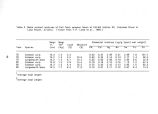| OCR Text |
Show impacts from the actions of appropriators outside of the NRA must also be considered in the water rights question. Although the water rights issue is legal or administrative in nature, field data, special studies, and literature searches may be required to support claims of the United States. A failure to address this issue at this time could lead to additional problems in the future of unknown magnitude and complexity. • Until recently the United States has been largely unaffected by water rights proceedings. This situation is changing rapidly throughout the West as states proceed to adjudicate their water rights with the particular intent of quantifying and adjudicating federal reserved and appropriated water rights. The immediate impact of the situation is found in the workload generated in preparing and supporting the claim of the United States in the ongoing adjudications in Utah. The United States has submitted to the State of Utah its claim to federal reserved water rights with a priority date of October 27, 1972. Included in its claim are quantifiable administrative uses from six water sources in the Colorado River and eight in the San Rafael River adjudications, respectively. The sources and amounts claimed in the Colorado River adjudication are the following: 1. Bullfrog Basin Well # 1 ( 0.334 cubic feet per second [ cfs]) 2. Bullfrog Basin Well # 2 ( 0.279 cfs) 3. Wahweap Well ( 0.33 cfs) 4. Lone Rock Well ( 0.30 cfs) 5. Dangling Rope Well ( 0.12 cfs) 6. Halls Crossing Test Well ( 0.13 cfs) In addition, a general claim has been filed for 13.38 cfs for the support of ongoing authorized livestock grazing activities with an 1864 date of priority. The sources and amounts claimed in the San Rafael River adjudication are these: 1. Horseshoe Canyon ( seep) 2. Horseshoe Canyon ( 0.75 gallons per minute [ gpm]) 24 |








































































































